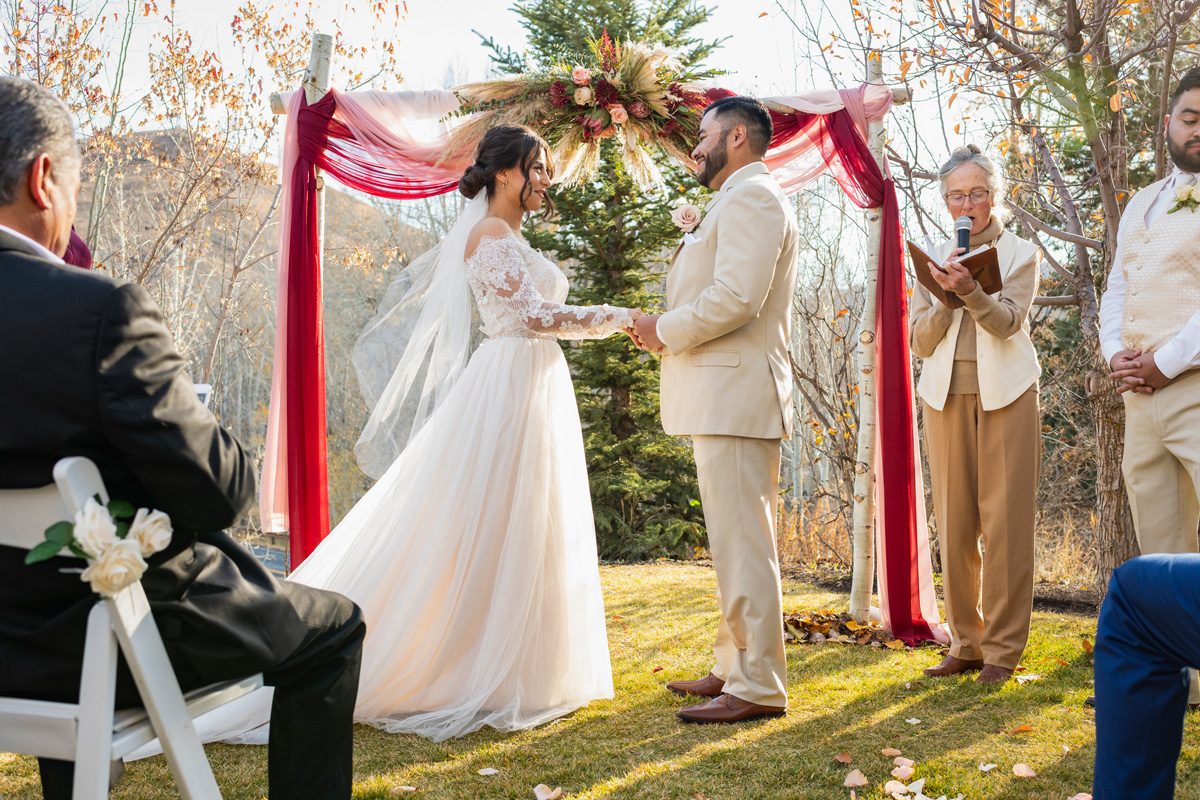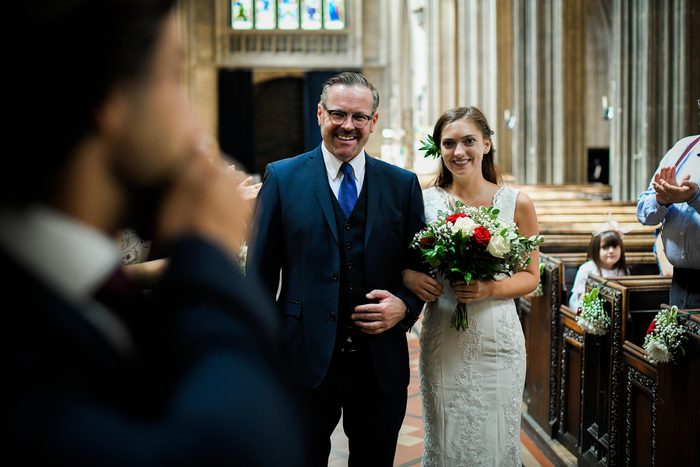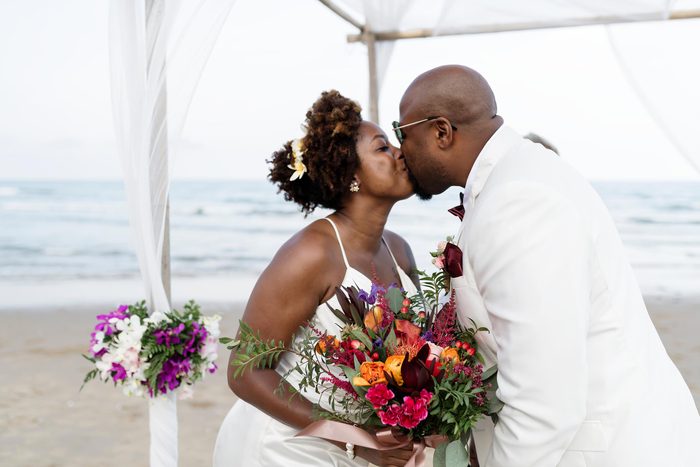Couples are ditching outdated wedding rules in favor of some less-conventional ideas—and we’re here for it

22 Outdated Wedding Rules Experts Say You Can Ignore


You need to get married in a house of worship
Couples these days are choosing to do away with religious ceremonies, which have been one of the most common wedding traditions for centuries. “We have had a few couples who opt to get married in a church and then come to our venue for their reception,” says Katie Elder, owner of Overlook Barn, a wedding venue in North Carolina. “But by far, the majority are skipping the church ceremony altogether and opting for a beautiful outdoor ceremony or a ceremony in one of our barns.”

Your wedding party has to be all women or all men
Today’s brides and grooms are redefining gender norms and placing a greater emphasis on gender inclusivity. And in the process, they’re rewriting the roles of groomsmen and bridesmaids. The groom doesn’t need to have only groomsmen as part of his wedding party, nor does the bride need to have only bridesmaids. “It is perfectly acceptable to have either gender as bridesmaids and groomsmen,” says Kristin Watkins, owner and lead planner at Stephanie Rose Events. “We have started using the term entourage to describe the wedding party.”

You need to mail printed invitations and RSVP cards
Printed invites and cards are now passé—wedding invitation etiquette has officially gone digital. “More couples are moving to email and digital invitations,” Watkins says. “It was common for my couples with international guests to email information rather than mail an invitation, but now it is acceptable for all weddings. Couples like that the responses are easier to track, and emailing saves on costs. Guests like that they can respond by clicking a link rather than mailing back a response card.” Bidding farewell to this outdated wedding rule is truly a win-win.

The bride’s parents pay for the wedding
The couple-funded wedding movement isn’t just gaining momentum; it’s becoming the norm. “Most of my couples pay for part or all of their wedding themselves, including the rehearsal dinner,” says Sarah Bradshaw, an experienced wedding and engagement photographer. “If the parents pay, it’s usually for specific things.” No matter who’s paying, many couples are finding creative ways to keep their wedding budget in check.

You need to have a big, formal rehearsal dinner
Planning the wedding can be a daunting task by itself. Add to this a big rehearsal dinner, and you’re practically doubling the effort—but not the fun. “Without the traditional financial roles or financial help from the parents, this formality becomes an unneeded expense, as modern couples see that they are essentially paying for two receptions,” says Amy McCord Jones, owner of Flower Moxie, which helps brides make their own DIY floral creations. “Instead, couples are opting for a quiet dinner with immediate family.”

Bridesmaids’ dresses should be identical
When we think of bridesmaids throughout history, we have an image of women wearing the exact same dresses. However, this outdated wedding rule is officially on the outs—to the delight of bridesmaids everywhere. “All the bridesmaids wearing the identical, solid color dress is less common as couples opt for more personal wedding party attire,” says Lindsey Nickel, a wedding planner at Lovely Day Events. “Couples are really embracing making the wedding feel like their own wedding and personalizing as much as possible. This is one of my favorite wedding trends because it allows people to pick a dress that flatters their figure and that they would realistically wear again.”

Guests choose their seats based on their relationship to the couple
Traditional weddings demarcated space for both sides of the wedding party. “Guests used to be required to sit on the left side of the aisle if they were from the bride’s side and on the right side of the aisle if they were on the groom’s side,” says wedding and event planner Ashley Gelfound. “However, nowadays, the wedding couple does not uphold this tradition. Instead, guests sit wherever they feel comfortable, and the bride’s side and groom’s side intermingle.”

The bride walks down the aisle with her father, and the groom enters alone
Talk about an outdated wedding rule that really needed to change with the times! Flexibility when it comes to who walks down the aisle is a breath of fresh air for brides and grooms alike. “More and more, we’re seeing brides wanting to walk down the aisle with both parents, which is beautiful,” says José Rolón, a wedding planner based in New York City. “We’re making more room for a three-person aisle. Also, grooms are now wanting to feel included in this and want to walk down with their parents as well.”

The couple can’t see each other before the ceremony
Considering this tradition dates back centuries, when fathers arranged marriages and worried about the groom bolting if he didn’t find the bride attractive enough, modern couples are more than happy to retire this outdated wedding rule. “Most couples do a first look and portraits now to help ease the stress of the wedding day schedule,” Bradshaw says.
And no, seeing your spouse-to-be before the ceremony isn’t actually bad luck. But couples who’d rather be safe than sorry can share a moment before walking down the aisle and then incorporate some lucky wedding traditions—like adding a small horseshoe to the bride’s outfit, a gesture rooted in Irish heritage—elsewhere in the ceremony.

Every guest needs a plus-one
There are some wedding etiquette rules that guests are expected to adhere to, but the mandatory plus-one isn’t one of them. A good guideline: Couples who are engaged or live together should get a plus-one, not just those who are married. For everyone else, you can use your discretion.

Guests can’t wear black to the wedding
“I think it’s appropriate to wear black to a wedding, especially if it’s a black tie wedding,” Nickel says. “Black is so chic and timeless. Guests who want to wear black should consider the venue and season. At a winery in the summer, a formal black dress would be out of place. However, a black sundress would fit in wonderfully. A black dress can be brightened up with colorful shoes and a bold statement necklace.” Likewise, a black suit is a classic for men, and you can always add a pop of color with a bright tie or go casual by leaving the jacket at home.

Your officiant has to be a religious figure
“Instead, we are seeing couples have their relatives—we’ve seen dads, moms, aunts and cousins—or friends officiate their wedding,” Elder says. “It brings a really special, intimate touch to the ceremony to have someone who knows the couple so well officiate it! Just be careful to make sure the person you choose is comfortable speaking in front of a crowd during a very special event.”
If you have your heart set on someone who isn’t good with public speaking, you can make their job easier by passing along some wedding jokes that can lighten the mood (and their nerves!). Bonus: Your ceremony just became more memorable.

Your wedding weekend should last only a day
“Rather than being a short celebration, we are seeing couples turn the entire weekend into a celebration, starting with a welcome party for out-of-town guests on the day prior to their wedding, going into the ceremony and reception, all the way to a brunch on the following day,” Elder says. “Creating more time for celebration means more fellowship with loved ones and a great weekendlong memory! This is especially true for destination weddings.”

You have to have a receiving line
Gone are the days of waiting around to formally greet and congratulate the couple in the receiving line. Now, you can just send some wedding wishes their way during the reception. “Receiving lines have disappeared over the years,” Nickel says. “This formality used to be expected at church weddings, but with so many wedding ceremonies taking place outdoors and feeling less formal, couples now skip the receiving line. Instead of receiving lines, couples are opting to go straight into wedding party photos and have more time to enjoy cocktail hour.”

The cake cutting has to be a huge affair
In the past, couples made a show of cutting their wedding cake during the reception, but this is becoming much less common, according to Bradshaw. “If couples do it at all, it’s often private, unannounced or quietly in a corner without many people around,” she says.

You have to have a wedding cake
These days, many couples opt out of the iconic wedding cake, choosing a dessert that better speaks to their personal sweet tooth. “We are seeing couples create a variety of dessert tables, including small dessert bites, pie spreads, doughnut walls or even candy stations,” Elder says. Once you’ve had a slice of generic white cake with white frosting, you’ll agree: This is a much-needed refresh to the outdated wedding rule!

You have to have kids at your wedding
More and more couples are choosing not to invite children to their wedding ceremony and reception to make the affair more sophisticated. “One of my couples is putting a no one under 25 rule, specifically to exclude some just-turned-21 cousins from attending their open-bar wedding,” Bradshaw says.

You need to do a bouquet-and-garter toss
“While this was a fun highlight of a wedding reception back in the day, it has now become the dreaded event that sends all singles to the bathroom in a mass exodus,” McCord Jones says. “Generally, women do not want their relationship status on display. Nor do they want to catfight for a bouquet in hopes that they will be the next lucky girl to head down the aisle. Brides are now sensitive to this and often hand off their bouquet to the couple that has been married the longest.”
Lisa Mark and Rebecca Lozer, wedding photographers turned co-hosts of The Secret Life of Weddings podcast, say you can update the bouquet-tossing tradition by having a dance for married couples instead. During the dance, the DJ can ask couples who have been married five years, 10 years, etc. to sit down. Eventually, the couple married the longest will remain, and the bouquet can be presented to them out of respect. It’s a great way to take the outdated wedding rule and turn it around on its head.

You can’t ask for cash gifts
Asking for cash gifts used to be a major wedding faux pas, but modern couples have a good reason for ditching the outdated rule: Most brides and grooms have been living on their own for years before marrying, and their homes are well-stocked with the sort of stuff that traditionally made the cut on wedding registries. Instead of asking for items they’ll never use, they go the practical route and request cash they can spend as they see fit. Some use it on their honeymoon. Others save it for a house. These shifts reflect broader changes in wedding gift etiquette that work better for both sides of the equation. Guests are spared the trouble of thinking of a gift, while couples can spend the cash as they like.

You need to give wedding favors
So long, inedible Jordan almonds. Farewell, random dodads you don’t need. Wedding favors may be on their way out. “Oftentimes they are a small, sometimes meaningless item for each guest,” says Logan Westom, a professional wedding photographer. “I have seen a lot of people just make fun of them or not appreciate them to the level that the bride and groom probably spent thinking about them. When I got married, my wife and I put that money into a donation in the name of everyone at our wedding to a charity that was important to us. We printed a small note at the bottom of each table menu for guests to see.”

Your honeymoon should be right after the wedding
“Most of my couples do a weekend mini-moon somewhere close by and then are back in the office by Tuesday after their wedding,” Bradshaw says. “They save up and take a big honeymoon trip six months or so after their wedding.”

You have to follow the rules
You get to decide what you want your celebration to look like—after all, it’s your wedding! “The rules are there are no rules,” Westom says. It’s your special day, so you can determine which are the outdated wedding rules and which are worth following. Don’t feel the need to play by any rulebook.
“This is what I tell my couples—if they want to do their wedding reception first and then do a ceremony, that is 100% OK. Do what makes sense for the both of you,” he says. “Your wedding is about you, and it should show your personality. If that means an early ceremony and tons of yard games and activities instead of dancing, that should be all right. Just because your mom and dad’s wedding was one way does not mean your wedding has to be that way too. Unless you are marrying someone in the royal family, you can do whatever you want.”
About the experts
|
Why trust us
Reader’s Digest has published hundreds of etiquette stories that help readers navigate communication in a changing world. We regularly cover topics such as the best messages to send for any occasion, polite habits that aren’t as polite as they seem, email and texting etiquette, business etiquette, tipping etiquette, travel etiquette and more. We’re committed to producing high-quality content by writers with expertise and experience in their field in consultation with relevant, qualified experts. We rely on reputable primary sources, including government and professional organizations and academic institutions as well as our writers’ personal experiences where appropriate. We verify all facts and data, back them with credible sourcing and revisit them over time to ensure they remain accurate and up to date. Read more about our team, our contributors and our editorial policies.
Sources:
- Katie Elder, owner of Overlook Barn
- Kristin Watkins, owner and lead event designer at Stephanie Rose Events
- Amy McCord Jones, owner of Flower Moxie
- Sarah Bradshaw, wedding and engagement photographer
- Lindsey Nickel, wedding planner at Lovely Day Events
- Ashley Gelfound, wedding and event planner
- José Rolón, founder of José Rolón Events, co-host of The Wedding Talk with Tara Lipinski TV series and The Wedding Buzz podcast
- Logan Westom, professional wedding photographer
- Brides: “Here’s Why Grooms Traditionally Don’t See the Bride Before the Wedding Ceremony”



















